
Higher_Mathematics_Part_1
.pdf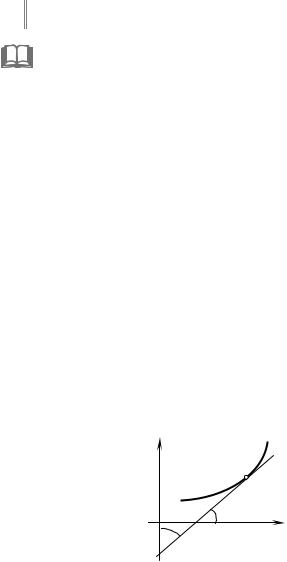

|
18.2. Differentiation of implicit function |
|
||
Let the implicit function |
y = f (x) is set by equation |
F(x, y) = 0. In order |
||
to find the |
derivative y′(x) , |
we need to differentiate both parts of equation |
||
F(x, y) = 0 |
with respect to |
x , and not to forget that |
y is |
a function of |
variable x . The obtained equation may be solved with respect to |
′ |
|||
y (x) . So, we |
||||
find derivative from the condition
dxd F(x, y) = 0.
Derivative of implicit function is expressed through the independent variable x and function y itself.
18.3. Differentiation of functions given parametrically
The derivative of function y = f (x), given by parametrical equation x = x(t),
y = y(t) (where x(t) and y(t) |
are differentiable at the point t and y′(t) = 0, is |
|||||||||
found by the formula |
|
|
|
|
|
|
|
|
||
|
d |
|
|
dy |
ψ′(t) or y′ |
|
yt′ |
|
||
|
= |
|
dt |
= |
= |
. |
||||
|
dx |
|
dx |
ϕ′(t) |
x |
|
xt′ |
|||
|
|
|
|
dt |
|
|
|
|
|
|
18.4. Logarithmic differentiation
In some cases while finding derivative we should at first take the logarithm of given function and then find the derivative as in the case of implicit functon. This operation is called logarithmic differentiation.
It is particularly convenient to use logarithmic differentiation if the function is represented as:
а) y = u1k1 (x) u2k2 (x) … umkm (x) (x) ; b) or y = u(x)v(x) . v1l1 (x) v2l2 (x) … vmln (x) (x)
Let’s show how to find the derivative of the function y = u(x)v(x) , where
u(x), v(x) are differentiable functions with respect to |
x, u(x) > 0 . |
|
|
|||||||
Applying the logarithm, we receive |
|
1 |
|
1 |
|
|||||
ln y = ln(uv ) = v ln u ; |
(ln y)′ = (v ln y)′ ; |
y′ = v′ lnu + v |
u′ ; |
|||||||
|
y |
|
||||||||
|
|
|
|
|
|
|
u |
|||
y′ = uv v′ ln u + v |
1 |
u′ = uv ln u |
v′ + vuv−1 u′ |
|
|
|||||
|
|
|
||||||||
|
|
u |
|
|
|
|
|
|
||
212 |
|
|
|
|
|
|
|
|
|
|
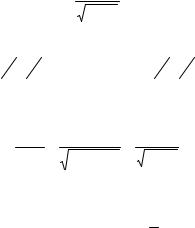

|
Example 6. Find |
|
y′ , if |
arctg |
y |
= ln |
|
x2 + y2 . |
|
|
|
|
|
|
|
|
|
||||||||||||||||||||||||||||||||||||||||
|
Solution. We have |
|
|
|
|
|
|
|
|
|
|
|
|
|
|
x |
|
|
|
|
|
|
|
|
|
|
|
|
|
|
|
|
|
|
|
|
|
|
|
|
|
|
|
|
|
||||||||||||
|
|
|
|
|
|
|
|
|
|
|
|
|
|
|
|
|
|
|
|
|
|
|
|
|
|
|
|
|
|
|
|
|
|
|
|
|
|
|
|
|
|
|
|
|
|
||||||||||||
|
d |
|
y |
|
|
d |
|
1 |
|
|
|
2 |
|
|
|
|
|
|
2 |
|
|
|
|
|
|
|
|
|
1 |
|
|
|
|
|
|
y ′ |
|
|
|
1 |
|
2 |
|
2 |
′ |
||||||||||||
|
|
arctg |
|
|
|
= |
|
|
|
|
|
|
ln(x |
|
+ y |
|
|
) |
, |
|
|
|
|
|
|
|
|
|
|
|
|
|
|
|
|
|
= |
|
|
(x |
|
+ y |
|
) , |
|||||||||||||
|
|
x |
dx |
2 |
|
|
|
|
|
|
|
|
|
|
|
y 2 |
|
|
(x2 + y2 ) |
|
|
||||||||||||||||||||||||||||||||||||
|
dx |
|
|
|
|
|
|
|
|
|
|
|
|
|
|
|
|
|
|
|
|
|
|
|
|
|
|
|
|
x |
2 |
|
|
|
|
|
|||||||||||||||||||||
|
|
|
|
|
|
|
|
|
|
|
|
|
|
|
|
|
|
|
|
|
|
|
|
|
|
|
|
|
|
1+ |
|
|
|
|
|
|
|
|
|
|
|
|
|
|
|
|
|
|
|||||||||
|
|
|
|
|
|
|
|
|
|
|
|
|
|
|
|
|
|
|
|
|
|
|
|
|
|
|
|
|
x |
|
|
|
|
|
|
|
|
|
|
|
|
|
|
|
|||||||||||||
|
|
|
x2 |
|
|
|
|
|
y′ − y |
|
|
|
|
2x + 2yy′ |
|
|
|
|
|
|
|
|
|
|
|
|
|
|
|
|
|
|
|
|
|
|
|
|
|
|
|
||||||||||||||||
|
|
|
|
|
|
|
|
= |
|
|
|
, |
|
y |
′x − y = x + yy′, y′(x − y) = x + y, |
|
|
||||||||||||||||||||||||||||||||||||||||
|
|
|
x2 + y2 |
|
|
|
x2 |
|
2(x2 + y2 ) |
|
|
|
|||||||||||||||||||||||||||||||||||||||||||||
so |
|
|
|
|
|
|
|
|
|
|
|
|
|
|
|
|
|
|
|
|
|
|
|
|
|
|
|
|
|
|
|
|
|
x + y |
|
|
|
|
|
|
|
|
|
|
|
|
|
|
|
|
|||||||
|
|
|
|
|
|
|
|
|
|
|
|
|
|
|
|
|
|
|
|
|
|
|
|
|
|
|
|
|
|
y′ = |
|
|
. |
|
|
|
|
|
|
|
|
|
|
|
|
|
|
||||||||||
|
|
|
|
|
|
|
|
|
|
|
|
|
|
|
|
|
|
|
|
|
|
|
|
|
|
|
|
|
|
|
|
|
|
|
|
|
|
|
|
|
|
|
|
|
|
|
|
||||||||||
|
|
|
|
|
|
|
|
|
|
|
|
|
|
|
|
|
|
|
|
|
|
|
|
|
|
|
|
|
|
|
|
|
|
|
|
x − y |
|
|
|
|
|
|
|
|
|
|
|
|
|
|
|
||||||
|
Example 7. Find |
|
y |
′ |
, if |
y = a sin t . |
|
|
|
|
|
|
|
|
|
|
|
|
|
|
|
|
|
|
|
|
|
|
|||||||||||||||||||||||||||||
|
|
|
|
|
|
|
|
|
|
|
|
|
|
x |
|
|
|
|
|
= b cos t |
|
|
|
|
|
|
|
|
|
|
|
|
|
|
|
|
|
|
|
|
|
|
|
|
|
||||||||||||
|
|
|
|
|
|
|
|
|
|
|
|
|
|
|
|
|
|
x |
|
|
|
|
|
|
|
|
|
|
|
|
|
|
|
|
|
|
|
|
|
|
|
|
|
||||||||||||||
|
Solution. y′(t) = a cost , |
x′(t) = −b sin t , then |
|
|
|
|
|
|
|
|
|
|
|
|
|
||||||||||||||||||||||||||||||||||||||||||
|
|
|
|
|
|
|
|
|
|
|
|
|
|
|
|
|
y′ |
|
= |
|
|
|
|
a cos t |
|
|
= − |
a |
ctg(t) . |
|
|
|
|
|
|
||||||||||||||||||||||
|
|
|
|
|
|
|
|
|
|
|
|
|
|
|
|
|
|
|
|
|
|
|
|
|
|
|
|
|
|
|
|
|
|
|
|
||||||||||||||||||||||
|
|
|
|
|
|
|
|
|
|
|
|
|
|
|
|
|
|
x |
|
|
|
|
|
− b sin t |
|
|
|
|
|
|
b |
|
|
|
|
|
|
|
|
|
|
|
|
|
|
|
|||||||||||
|
|
|
|
|
|
|
|
|
|
|
|
|
|
|
|
|
|
|
|
|
|
|
|
|
|
|
|
|
|
|
|
|
|
|
|
|
|
|
|
|
|
|
|
|
|||||||||||||
|
Example 8. Find |
|
y |
′ |
, if |
|
|
|
= t |
2 |
− 2t |
3 |
|
|
|
|
|
|
|
|
|
|
|
|
|
|
|
|
|
|
|
|
|
|
|||||||||||||||||||||||
|
|
y |
|
. |
|
|
|
|
|
|
|
|
|
|
|
|
|
|
|
|
|
|
|
|
|||||||||||||||||||||||||||||||||
|
|
|
|
|
|
|
|
|
|
|
|
|
|
x |
|
|
|
|
|
= 2t + t |
|
|
|
|
|
|
|
|
|
|
|
|
|
|
|
|
|
|
|
|
|
|
|
|
|
|
|||||||||||
|
|
|
|
|
|
|
|
|
|
|
|
|
|
|
|
|
|
x |
2 |
|
|
|
|
|
|
|
|
|
|
|
|
|
|
|
|
|
|
|
|
|
|
|
|
|
|||||||||||||
|
|
|
|
|
|
|
|
|
|
|
|
|
|
|
|
|
|
|
|
|
|
|
|
|
|
|
|
|
|
|
|
|
|
|
|
|
|
|
|
|
|
|
|
|
|
|
|
|
|
|
|
|
|
|
|
|
|
|
Solution. Let’s find the derivatives |
|
|
|
|
|
|
|
|
|
|
|
|
|
|
|
|
|
|
|
|
|
|
|
|
|
|
||||||||||||||||||||||||||||||
|
|
|
|
|
|
|
|
|
|
|
|
|
|
|
|
y′(t) = 2t − 6t 2 , x′(t) = 2 + 2t , |
|
|
|
|
|
|
|||||||||||||||||||||||||||||||||||
|
|
|
|
|
|
|
|
|
|
|
|
|
|
|
|
then |
|
|
y′ |
|
= |
|
2t |
− 6t |
2 |
|
= |
t |
− 3t |
2 |
. |
|
|
|
|
|
|
|
|||||||||||||||||||
|
|
|
|
|
|
|
|
|
|
|
|
|
|
|
|
|
|
|
|
|
|
|
|
|
|
|
|
|
|
|
|
|
|
|
|
|
|
|
|
|
|
|
|
||||||||||||||
|
|
|
|
|
|
|
|
|
|
|
|
|
|
|
|
|
|
|
|
|
|
|
|
|
x |
|
|
|
2 + 2t |
|
|
|
|
|
1+ t |
|
|
|
|
|
|
|
|
|
|||||||||||||
|
|
|
|
|
|
|
|
|
|
|
|
|
|
|
|
|
|
|
|
|
|
|
|
|
|
|
|
|
|
|
|
|
|
|
|
|
|
|
|
|
|
|
|
||||||||||||||
|
|
|
|
|
|
|
|
|
|
|
|
|
|
|
|
|
|
|
y |
= arctg (t) |
|
|
|
|
|
|
|
|
|
|
|
|
|
|
|
|
|
|
|
|
|||||||||||||||||
|
Example 9. Find |
|
y |
′ |
, if |
|
. |
|
|
|
|
|
|
|
|
|
|
|
|
|
|
|
|
|
|
|
|||||||||||||||||||||||||||||||
|
|
|
|
|
|
|
|
|
|
|
|
|
|
|
|
|
|
|
|
|
|
|
|
|
|
|
|
|
|
|
|
|
|
|
|
|
|
|
|||||||||||||||||||
|
|
|
|
|
|
|
|
|
|
|
|
|
|
x |
|
|
x = ln (1+ t2 ) |
|
|
|
|
|
|
|
|
|
|
|
|
|
|
|
|
|
|
|
|
||||||||||||||||||||
|
|
|
|
|
|
|
|
|
|
|
|
|
|
|
|
|
|
|
|
|
|
|
|
|
|
|
|
|
|
|
|
|
|
|
|
|
|
|
|
|
|
|
|
|
|
|
|
|
|
|
|
|
|
|
|
|
|
|
|
|
|
|
|
|
|
|
|
|
|
|
|
|
|
|
|
|
|
|
|
|
|
|
|
|
|
|
|
|
|
|
|
|
|
|
|
|
|
|
|
|
|
|
|
|
|
|
|
|
|
|
|
|
|
|
|
|
Soluton. We have |
y′ = |
|
1 |
|
|
|
|
, |
|
x′(t) = |
|
|
2t |
. Then |
|
|
|
|
|
|
||||||||||||||||||||||||||||||||||||
|
|
+ t 2 |
|
|
|
|
1 |
+ t 2 |
|
|
|
|
|
|
|||||||||||||||||||||||||||||||||||||||||||
|
|
|
|
|
|
|
|
|
|
|
|
|
|
|
|
1 |
|
|
|
|
|
|
|
|
|
|
|
|
|
|
|
|
|
|
|
|
|
|
|
|
|
|
|
|
|
||||||||||||
|
|
|
|
|
|
|
|
|
|
|
|
|
|
|
|
|
|
y |
′ |
|
|
|
|
|
|
|
1 |
|
|
|
1+ t2 |
|
|
1 |
|
|
|
|
|
|
|
|
|
|
|
||||||||||||
|
|
|
|
|
|
|
|
|
|
|
|
|
|
|
|
|
|
= 1+ t2 |
|
|
|
|
2t |
|
= 2t . |
|
|
|
|
|
|
|
|
|
|||||||||||||||||||||||
|
|
|
|
|
|
|
|
|
|
|
|
|
|
|
|
|
|
|
|
|
|
|
|
|
|
|
|
|
|
|
|
|
|||||||||||||||||||||||||
214 |
|
|
|
|
|
|
|
|
|
|
|
|
|
|
|
|
|
|
|
|
|
|
|
|
|
|
|
|
|
|
|
|
|
|
|
|
|
|
|
|
|
|
|
|
|
|
|
|
|
|
|
|
|
|
|
|
|
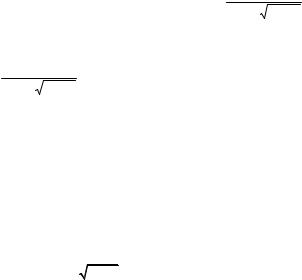
Example 10. Find the derivative of function |
y = |
x2 |
(3x − 2)ex |
|
sin x |
. |
|||
|
|
2x + 1 |
||
Solution. We use logarithmic differentiation and receive:
|
x2 (3x − 2)ex |
|
; |
ln y = 2 ln x + ln(3x − 2)+ x − ln sin x − |
1 |
ln(2x + 1); |
|||||||||||||
ln y = ln |
|
|
|
|
|
||||||||||||||
|
|
|
|
|
|
|
|
|
|
|
|
|
|
|
|
|
2 |
|
|
sin x 2x + 1 |
|
|
|
|
|
|
|
|
|
|
|
|
|
|
|||||
|
ln y = 2 ln x + ln(3x − 2)+ x − ln sin x − 1 ln(2x + 1); |
|
|
||||||||||||||||
|
|
|
|
|
|
|
|
|
|
|
|
|
2 |
|
|
|
|
||
|
|
1 |
y′ = |
2 |
+ |
|
3 |
+ 1− |
1 |
cos x − |
1 |
; |
|
|
|
||||
|
|
|
x |
3x − 2 |
sin x |
2x + 1 |
|
|
|
||||||||||
|
|
y |
|
|
|
|
|
|
|
|
|
|
|
|
|||||
|
y′ = y |
2 |
+ |
|
3 |
+ 1− |
|
1 |
cos x − |
|
1 |
|
, |
|
|
||||
|
|
|
|
|
|
|
|
|
|
|
|
|
|||||||
|
|
x |
|
3x − 2 |
|
sin x |
|
2x + 1 |
|
|
|||||||||
|
|
|
|
|
|
|
|
|
|
|
|
|
|
|
|||||
or |
|
|
|
|
|
|
|
|
|
|
|
|
y′ = |
x2 |
(3x − |
2)ex |
2 |
+ |
3 |
+ 1 |
− ctg x − |
1 |
|
|
|
|
|
|
|
|
|
|
. |
|||||
sin x 2x + 1 |
3x − 2 |
2x + 1 |
||||||||||
|
x |
|
|
|
|
|||||||
Example 11. Find the derivative of function y = xcos x .
Solution. First method. Let’s use logarithmic differentiation. We have
ln y = ln xcos x ; |
ln y = cos x ln x; |
(ln y)′ = (cos x ln x)′; |
|||||||
y′ |
|
|
1 |
|
|
|
1 |
|
|
|
= − sin x ln x |
+ cos x |
|
; |
y′ = y |
− sin x ln x + cos x |
x |
. |
|
y |
x |
||||||||
|
|
|
|
|
|
||||
That is,
|
|
y′ = x |
cos x |
|
− sin x ln x + cos x |
1 |
|
|
|
|||||
|
|
|
|
x |
. |
|
|
|||||||
|
|
|
|
|
|
|
|
|
|
|
|
|
|
|
Second method. Using basic logarithmic equality |
aloga b = b, |
let's write |
||||||||||||
the given function as |
|
|
|
|
|
|
|
|
|
|
|
|
||
|
|
y = xcos x |
= (eln x )cos x |
= ecos xln x . |
|
|
|
|||||||
Then |
|
|
|
|
|
|
|
|
|
|
|
|
|
|
|
|
y′ = (ecos xln x )′ = ecos xln x (cos x ln x)′ = |
|
|
||||||||||
= e |
cos xln x |
− sin x ln x + cos x |
1 |
|
= x |
cos x |
|
|
1 |
|
||||
|
x |
|
|
− sin x ln x + cos x |
x |
. |
||||||||
|
|
|
|
|
|
|
|
|
|
|
|
|
||
|
|
|
|
|
|
|
|
|
|
|
|
|
|
215 |

Micromodule 18
CLASS AND HOME ASSIGNMENT
Find dydx using the rule of differentiation of inverse function, if:
1. |
x = y2 + |
y2 + 1 . |
|
|
|
|
|
|
2. |
|
x = y ln y + sin y. |
|
|
|
|
|
|||||||||||||||||||
3. |
x = lg cos y + cos ln y. |
|
|
|
|
4. |
|
x = earccos y . |
|
|
|
|
|
|
|||||||||||||||||||||
Find the derivative |
|
y′ |
of implicit functions: |
|
|
|
|
|
|
|
|||||||||||||||||||||||||
5. 3x+y |
= 3x −3y . |
|
|
|
6. |
|
arctg |
|
y |
|
= |
|
x2 + y2 . |
7. x y = yx . |
|
||||||||||||||||||||
|
|
|
|
x |
|
|
|||||||||||||||||||||||||||||
|
|
|
|
|
|
|
|
|
|
|
|
|
|
|
|
|
|
|
|
|
|
|
|
|
|
|
|
|
|
|
|
|
|
||
8. x |
3 |
+ y |
3 |
= 3xy . |
|
|
|
9. |
|
x2 |
|
+ |
y |
2 |
|
=1. |
|
|
|
|
|
|
|
|
|||||||||||
|
|
|
|
|
|
a2 |
b2 |
|
|
|
|
|
|
|
|
||||||||||||||||||||
|
|
|
|
|
|
|
|
|
|
|
|
|
|
|
|
|
|
|
|
|
|
|
|
|
|
|
|
|
|
||||||
Find the derivative |
|
y′ |
of functions given parametrically: |
|
|
|
|
||||||||||||||||||||||||||||
|
|
|
|
|
|
|
|
|
|
|
|
|
|
x |
|
|
|
|
|
|
|
|
|
|
|
|
|
|
|
|
|
|
|
|
|
10. |
x = a cos2 t , y = b sin2 t . |
|
|
|
11. x = t , |
y = 3 t . |
|
|
|
|
|||||||||||||||||||||||||
12. |
x = |
|
|
3at |
|
, |
y = |
3at2 |
. |
|
|
13. |
x = et , |
y = e2t . |
|
|
|
|
|
||||||||||||||||
|
|
|
|
1 |
+t3 |
|
|
|
|
1+t3 |
|
|
|
|
|
|
|
|
|
|
|
|
|
|
|
|
|
|
|
||||||
14. x = et |
cos t , |
y = et |
sin t . |
|
|
15. |
x = a(t −sin t) , |
y = a(1−cos t) . |
|
||||||||||||||||||||||||||
16. |
x = t2 , |
y = |
t3 |
|
−t . |
|
|
|
|
17. |
x = e2t |
cos2 t , |
y = e2t |
sin2 t . |
|
||||||||||||||||||||
|
|
|
|
|
|
|
|||||||||||||||||||||||||||||
|
|
|
|
|
|
|
|
|
|
3 |
|
|
|
|
|
|
|
|
|
|
|
|
|
|
|
|
|
|
|
|
|
|
|
|
|
18. |
x = t cos t , |
y = t sin t . |
|
|
|
|
19. |
x = |
cos3 t |
, y = |
sin3 |
t |
. |
|
|||||||||||||||||||||
|
|
|
|
cos 2t |
cos 2t |
|
|||||||||||||||||||||||||||||
|
|
|
|
|
|
|
|
|
|
|
|
|
|
|
|
|
|
|
|
|
|
|
|
|
|
|
|
|
|
|
|
||||
Find the derivative |
|
y′ , using logarithmic differentiation: |
|
|
|
|
|||||||||||||||||||||||||||||
20. |
y = (ln x)x . |
|
|
|
|
|
21. |
y = (2x +1)2x−1 . |
|
22. y = |
2x tg x 5 x |
. |
|||||||||||||||||||||||
|
|
|
|
|
|
|
3x −4 |
||||||||||||||||||||||||||||
|
|
|
|
|
|
|
|
|
|
|
|
|
|
|
|
|
|
|
|
|
|
|
|
|
|
|
|
|
|
|
|
|
|
|
|
23. |
y = (x − 4) |
x3 + 3 . |
|
|
|
|
24. |
y = (x5 +5 |
x )arctg x . |
|
|
|
|||||||||||||||||||||||
|
|
|
|
|
|
|
(x − 2)3 x |
|
|
|
|
|
|
|
|
|
|
|
|
|
|
|
|
|
|
|
|||||||||
25. |
y = xln x +(ln x)x . |
|
|
|
|
|
|
26. |
y = (sin x)cos x (cos x)sin xx . |
|
|
||||||||||||||||||||||||
27. |
y = (x5 +5 |
|
x )arctg x . |
|
|
|
|
28. |
y = xxx . |
|
|
|
|
|
|
||||||||||||||||||||
216

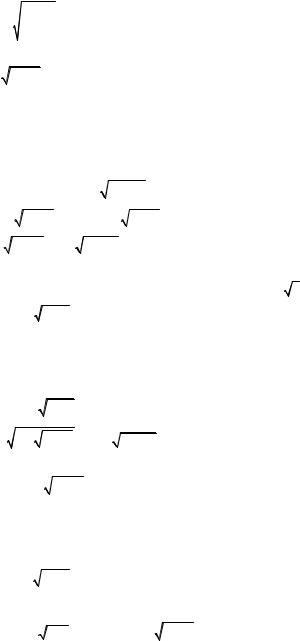
|
|
|
|
|
|
|
1−t2 |
|
|
|
|
|
|
|
|
|
2 |
|
|
|
|
|
|
−t2 |
|
|
|
|
−t |
|
|
|
|
|
|||||||||||
18.2.5. y = ln |
|
|
|
|
|
|
|
|
|
, x = arctg t |
|
. |
18.2.6. y = e |
|
, |
|
|
x |
= e |
. |
|
|
|
||||||||||||||||||||||
|
|
|
1+t2 |
|
|
|
|
|
|||||||||||||||||||||||||||||||||||||
18.2.7. y = |
|
|
|
|
t |
|
, |
|
|
x = (arcsin t)2 . |
18.2.8. y = et |
sin t , |
x = et |
cos t . |
|||||||||||||||||||||||||||||||
|
|
1−t2 |
|
|
|
||||||||||||||||||||||||||||||||||||||||
|
|
|
|
|
|
|
|
|
|
|
|
|
|
|
|
|
|
|
|
|
|
|
|
|
|
|
|
|
|
|
|
|
|
|
|
|
|
|
|||||||
18.2.9. y = |
1 |
|
|
|
, |
|
x = ln cos t . |
|
|
18.2.10. y = |
|
2at2 |
, |
x = |
|
|
|
bt |
|
. |
|||||||||||||||||||||||||
|
sin |
2 |
|
t |
|
|
|
|
|
|
|
|
|
|
|
|
|
|
|
|
|
|
|
|
1+t3 |
|
1 |
+t3 |
|
||||||||||||||||
18.2.11. y = a(1−cos 2t) , |
x = a(2t −sin 2t) . |
|
|
|
|
|
|
|
|
|
|
|
|
|
|
||||||||||||||||||||||||||||||
18.2.12. y = a(sin t −t cos t) , |
|
x = a(t sin t +cos t) . |
|
|
|
|
|
|
|
|
|
|
|
|
|
|
|||||||||||||||||||||||||||||
18.2.13. y = arcsin(t −1) , x = |
|
|
2t −t2 . |
|
|
|
|
|
|
|
|
|
|
|
|
|
|
||||||||||||||||||||||||||||
18.2.14. y = t |
|
|
|
t2 −1 , x = ln(t + t2 −1) . |
|
|
|
|
|
|
|
|
|
|
|
|
|
|
|||||||||||||||||||||||||||
18.2.15. y = 3 ln tg t , x = |
arctg t . |
|
18.2.16. y = t −arctgt , x = ln ctgt . |
||||||||||||||||||||||||||||||||||||||||||
18.2.17. y = |
cos t |
|
, x = (1+cos t)2 . |
18.2.18. y = |
tg t |
|
, |
x = |
ctg 2t |
. |
|
||||||||||||||||||||||||||||||||||
|
|
|
sin2 t |
|
|
|
|
|
|
|
|
|
|
|
|
|
|
|
|
|
|
|
1−t2 |
|
|
|
|
|
|
3 |
|
|
|
||||||||||||
18.2.19. y = ln |
1+ |
|
|
1−t2 |
|
|
1 |
|
|
18.2.20. y = |
|
|
|
at |
|
|
|
|
x = |
|
|
t2 |
|
||||||||||||||||||||||
|
|
|
|
|
|
|
|
|
|
|
|
|
, x = |
|
|
|
. |
|
|
|
|
|
, |
|
|
|
|
|
. |
||||||||||||||||
|
|
|
|
|
|
|
|
|
|
|
t |
|
|
|
|
|
|
|
|
ln2 |
t |
|
1 |
+t2 |
|
|
|
1+t2 |
|
||||||||||||||||
18.2.21. y = 2sin2 t + sin 2t , |
x = 3 tg 2t . |
|
|
|
|
|
|
|
|
|
|
|
|
|
|
||||||||||||||||||||||||||||||
18.2.22. y = ln ctg et , x = tg(2e−t ) . |
|
|
|
|
|
|
|
|
|
|
|
|
|
|
|
|
|
|
|
|
|
|
|||||||||||||||||||||||
18.2.23. y = arcsin |
|
|
1− t2 , |
x = arctg(t2 − 1) . |
|
|
|
|
|
|
|
|
|
|
|
|
|
|
|||||||||||||||||||||||||||
18.2.24. y = 1+ t2 −1 , |
x = 3 1−ln t . |
|
|
|
|
|
|
|
|
|
|
|
|
|
|
||||||||||||||||||||||||||||||
18.2.25. y = arccos |
|
1 |
|
|
|
x = arcsin |
|
t |
|
|
|
|
|
|
|
|
|
|
|
|
|
|
|||||||||||||||||||||||
|
|
|
|
, |
|
|
|
. |
|
|
|
|
|
|
|
|
|
|
|
|
|
|
|||||||||||||||||||||||
|
1+t2 |
|
1+t2 |
|
|
|
|
|
|
|
|
|
|
|
|
|
|
||||||||||||||||||||||||||||
18.2.26. y = t −arctg |
|
1 |
, x = t3 −arcctg |
1 |
. |
|
|
|
|
|
|
|
|
|
|
|
|
|
|
||||||||||||||||||||||||||
|
|
|
|
|
|
|
|
|
|
|
|
|
|
|
t |
|
|
|
|
|
|
|
t2 |
|
|
|
|
|
|
|
|
|
|
|
|
|
|
||||||||
18.2.27. y = (2 +3ln t) / t , |
x = a cos3 t . |
|
|
|
|
|
|
|
|
|
|
|
|
|
|
||||||||||||||||||||||||||||||
18.2.28. y = arctg |
1+ t2 , |
x = arccos1/ t2 . |
|
|
|
|
|
|
|
|
|
|
|
|
|
|
|||||||||||||||||||||||||||||
18.2.29. y = tg3 2t + ctg3 2t , |
x = cos 2t −sin 2t . |
|
|
|
|
|
|
|
|
|
|
|
|
|
|
||||||||||||||||||||||||||||||
18.2.30. y = arcsin |
|
|
1− t , |
x = arccos 1−t2 . |
|
|
|
|
|
|
|
|
|
|
|
|
|
|
|||||||||||||||||||||||||||
218
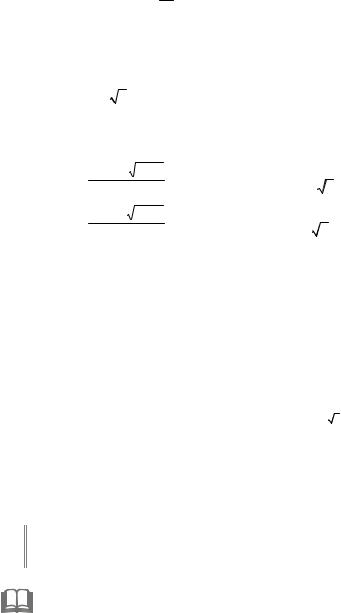
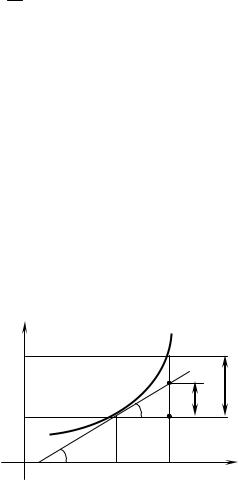
19.1. Definition and geometrical interpretation of differential
Let function y = f (x) be differentiable at the point x, so that it has the derivative at this point:
f ' (x) = lim |
y |
. |
|
||
x→0 |
x |
|
In general case f ' (x) ≠ 0 . Then |
|
|
yx = f ' (x) + α , where α → 0 if x → 0 , therefore the increment of the function is
y = f '(x) x + α x.
The first term is linear with respect to x , the second one is infinitesimal of the higher order than x . Therefore the first term forms the main part of the increment of function, which is called the differential of function.
Definition 3.21. The main, linear with respect to |
x , part of the increment |
||||||
of function |
f (x) is called the differential dy of function y = f (x) : |
||||||
|
|
|
|
|
|
|
|
|
|
|
dy = f ′(x) |
x . |
|
|
|
|
|
|
|
|
|
|
|
Differential dy |
is also termed |
as the |
first-order |
differential or the first |
|||
differential. |
|
|
|
|
|
|
|
If y = x |
then |
dy = dx = x' x = |
x , so the differential of the independent |
||||
variable x is equal to its increment. Therefore:
dy = f ′(x)dx .
The geometrical interpretation of the differential is clear from Fig.3.16.
у |
|
|
|
|
f(x + x) |
|
|
P• |
|
|
y = f(x) |
Q |
|
|
|
|
у |
||
|
|
|
dу |
|
|
M |
α |
|
|
|
|
|
||
f(x) |
• |
N |
|
|
x |
|
|||
|
|
|
|
|
|
α |
|
A |
|
О |
x |
|
x + x |
х |
Fig. 3.16
220
